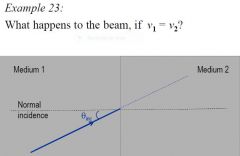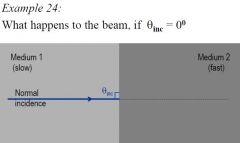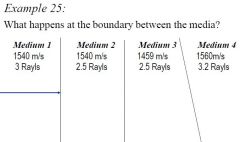![]()
![]()
![]()
Use LEFT and RIGHT arrow keys to navigate between flashcards;
Use UP and DOWN arrow keys to flip the card;
H to show hint;
A reads text to speech;
25 Cards in this Set
- Front
- Back
|
Example 1: log 100 =
log 10,000 = log 0.01 = log 0.00001 = |
.
|
|
|
Example 2:
log 5 + log 6 = log (2^ 4) = |
.
|
|
|
Example 3:
If value a is 1000 times bigger then value b, in log scale it’s only ____ |
.
|
|
|
Example 4:
Sonographer increases the output power by 3 dB. How did the power change in linear scale? |
.
|
|
|
Example 5:
Technologist increases the intensity of the ultrasound by 6 dB. What is the increase in linear scale? What is the final intensity? |
.
|
|
|
Example 6:
Calculate total attenuation if the intensity at a certain depth is decreased to ½ of its original value. |
.
|
|
|
Example 7:
Calculate total attenuation if the intensity at a certain depth is decreased to 1/10,000 of its original value. |
.
|
|
|
Example 8:
Intensity of the ultrasound is reduced by 20 dB What is the ratio of intensities? |
.
|
|
|
Example 9:
Intensity of the ultrasound is decreased by 3 dB. What is the initial intensity, if the final intensity was 5 mW/cm2? |
.
|
|
|
Example 10:
Calculate total attenuation if the amplitude of an ultrasound wave at a certain depth is decreased to ½ of its original value. |
.
|
|
|
Example 11:
Calculate total attenuation if the amplitude of an ultrasound wave at a certain depth is decreased to 1/100 of its original value. |
.
|
|
|
Example 12:
Calculate the intensity loss due to absorption for the 7.5 MHz ultrasound beam that traveled 5cm in soft tissue. |
.
|
|
|
Example 13:
Calculate the intensity loss due to absorption for the 5 MHz ultrasound beam at a depth of 4cm. |
.
|
|
|
Example 14:
Calculate the intensity loss due to absorption for the echo received from a depth of 5cm using 7.5MHz transducer. |
.
|
|
|
Example 15:
Calculate the intensity loss due to absorption for the echo received from a depth of 12cm using 2.5MHz transducer. |
.
|
|
|
Example 16:
How many HVL did the ultrasound travel if the original intensity is reduced by 9 dB? |
.
|
|
|
Example 17:
What is the HVL in soft tissues if 2.5 MHz transducer is in use? |
.
|
|
|
Example 18:
Calculate attenuation due to reflection at the soft tissue - bone interface, if impedance in soft tissue is 1.6 x 106 Rayl and impedance in bone is 7.8 x 106 Rayl. |
.
|
|
|
Example 19:
Calculate attenuation due to reflection at the air -soft tissue interface, if impedance in soft tissue is 1.6 x 106 Rayl and impedance in air is 0.0004 x 106 Rayl. |
.
|
|
|
Example 20:
Calculate the total attenuation for the echos received from the depth of 5cm at the muscle - liver interface, if the impedance in muscle is 1.7 x 106 Rayl and the impedance in liver is 1.64 x 106 Rayl. Assume a 5 MHz transducer is in use. |
.
|
|
|
Example 21:
Calculate the total attenuation for the echos received from the depth of 20cm at the soft tissue - blood interface, if the impedance in soft tissue is 1.63 x 106 Rayl and the impedance in blood is 1.62 x 106 Rayl. Assume a 2.5 MHz transducer is in use. |
.
|
|
|
Example 22:
What is the ratio of final intensity to initial intensity in the previous example 21? example 21: Calculate the total attenuation for the echos received from the depth of 20cm at the soft tissue - blood interface, if the impedance in soft tissue is 1.63 x 106 Rayl and the impedance in blood is 1.62 x 106 Rayl. Assume a 2.5 MHz transducer is in use. |
.
|
|

|
.
|
|

|
.
|
|

|
.
|

